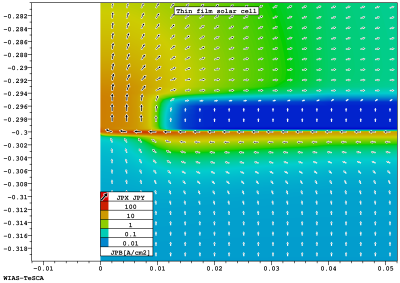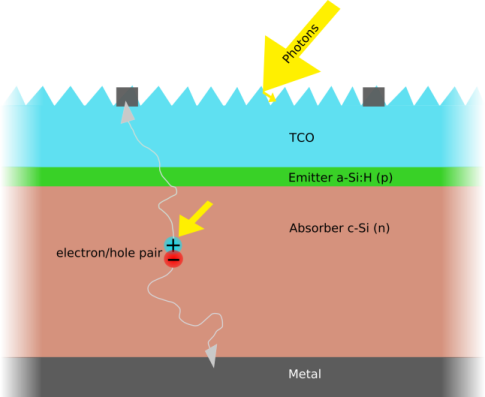Modeling of Electronic Properties of Interfaces in Solar Cells
| Coworker | Annegret Glitzky, Alexander Mielke, Matthias Liero, Reiner Nürnberg |
| Cooperation |
|
| Period | June 2010 - May 2014 |
| Support |
DFG Research Center MATHEON Mathematics for key technologies: Modelling, simulation, and optimization of real-world processes, Project D22 |
Scope
Solar cells consist of layers of different semiconducting materials, e.g. amorphous silicone (a-Si:H) and crystalline silicone (c-Si). In thin-film solar cells the interfaces have a strong impact on the functionality of the device. Nanoscale-treatment of interfaces like doping near the interface or deposition of atoms into the interface is used to tune the electronic properties. Our partners at the Helmholtz-Zentrum Berlin für Materialien und Energie (HZB) are investigating solar cell concepts containing layers of amorphous and crystalline silicon (a-Si:H/c-Si). The key issues for enhancing the efficiency are the reduction of recombination losses at the a-Si:H/c-Si interface and the improvement of the charge-carrier transport over the heterointerface.
The bulk equations are drift-diffusion models for the charge carriers coupled with ODEs for immobile defects, which may capture and release electrons or holes. The light that generates the electron-hole pairs, is treated as a given source term in our modeling, while it is calculated in project D23. While the equations in the bulk are well established, the modeling of the kinetics of defects on transition layers and at interfaces is a topic of current research in the physics community. The band offsets at the interface and the non-vanishing state density in the a-Si:H mobility gap provide complications, e.g. tunneling of electrons from c-Si layers into defect states with energy levels inside the band gap of a-Si layers. So far, there was no mathematical theory for special interface conditions. For heterogeneous materials always the classical interface conditions are used, like the continuity of normal fluxes and chemical potentials.
The aim of this project is to find reasonable hybrid models for electronic properties of solar cells coupling partial differential equations in the bulk with reaction-diffusion systems on the interface via suitable linear and nonlinear transmission conditions. These models are then studied regarding their analytical properties. Finally, the derivation of suitable numerical approximation schemes is necessary to provide simulation results.
In September 2012 the International Workshop Mathematics for Semiconductor Heterostructures - Modeling, Analysis, and Numerics organized by F. Nier, H.-Ch. Kaiser, K. Gärtner, and A. Glitzky took place at WIAS Berlin.



Publications
-
Feel the heat: Nonlinear electrothermal feedback in Organic LEDs
Advanced Functional Materials, online: DOI: 10.1002/adfm.201303066, 2014.
WIAS Preprint 1839, 2013. -
Convergence of an implicit Voronoi finite volume method for reaction-diffusion problems
WIAS Preprint 1827 2013. -
Uniform global bounds for solutions of an implicit Voronoi finite volume method for reaction-diffusion problems
Numer. Math., online: DOI 10.1007/s00211-014-0604-6, 2014.
WIAS Preprint 1718, 2012 -
Self-heating, bistability, and thermal switching in organic semiconductors
Phys. Rev. Lett., 110 pp. 126601/1--126601/5, 2013. -
Gradient structures and geodesic convexity for reaction-diffusion systems
Phil. Trans. R. Soc. A, 371 (2013) pp. 20120346/1--20120346/28
WIAS Preprint 1701, 2012 -
Self-heating effects in organic semiconductor crossbar structures with small active area
Organic Electronics, 13, pp. 2461-2468, 2012
WIAS Preprint 1693, 2012 -
Passing from bulk to bulk/surface evolution in the Allen-Cahn equation
NoDEA, Volume 20, Issue 3 , pp. 919-942, 2013. Online First
WIAS Preprint 1676, 2012 -
An electronic model for solar cells including active interfaces and energy resolved defect densities
SIAM J. Math. Anal., 44 pp. 3874--3900, 2012
WIAS Preprint 1663, 2011 -
Thermomechanical modeling of energy-reaction-diffusion systems, including bulk-interface interactions
Discrete Contin. Dyn. Syst.-S, 6(2) pp. 479-499, (2013).
WIAS Preprint 1661, 2011 -
A gradient structure for systems coupling reaction-diffusion effects in bulk and interfaces,
Z. Angew. Math. Phys. 64, pp. 29-52, (2013).
WIAS Preprint 1603, 2011 -
Analysis of electronic models for solar cells including energy resolved defect densities,
Math. Methods Appl. Sci. 34, pp. 1980-1998, 2011
WIAS Preprint 1524, 2010 -
A gradient structure for reaction-diffusion systems and for energy-drift-diffusion systems,
Nonlinearity 24 pp. 1329-1346, 2011
WIAS Preprint 1485, 2010 -
Uniform exponential decay of the free energy for Voronoi finite volume discretized reaction-diffusion systems,
Math. Nachr. 284 17-18 pp. 2159-2174, 2011
WIAS Preprint 1443, 2009
Proceedings
-
Electro-thermal modeling of organic semiconductors describing negative differential resistance induced by self-heating
in: Proceedings of the 13th International Conference on Numerical Simulation of Optoelectronic Devices, NUSOD 2013, 19--22 August 2013, J. PIPREK, L. CHROSTOWSKI, eds., IEEE Conference Publications Management Group, Piscataway, NJ, USA, 2013, pp. 77--78.
On the analysis of an electronic model for solar cells including energy resolved defect densities,
PAMM, Proceedings in Applied Mathematics and Mechanics, Special Issue: GAMM Annual Meeting 2011 - Graz. pages Wiley-VCH Verlag, Weinheim, pp. 675-676, (DOI: 10.1002/pamm.2011110327), 2011-
On discrete Sobolev-Poincaré inequalities for Voronoi finite volume approximations,
In J. Fort, J. Fürst, J. Halama, R. Herbin, and F. Hubert, editors, Finite volumes for complex applications VI: Problems and perspectives, pp. 533-541. Springer Proceedings in Mathematics 4, Heidelberg, 2011 -
Derivation of effective interface conditions for reaction-diffusion equations,
PAMM, Proceedings in Applied Mathematics and Mechanics, Special Issue: GAMM Annual Meeting 2011 - Graz. pages Wiley-VCH Verlag, Weinheim, pp. 677-678 (DOI: 10.1002/pamm.201110328), 2011
Talks
-
Nonlinear electrothermal feedback in organic semiconductors
Organic Photovoltaics Workshop 2013, December 10 - 11, 2013, University of Oxford, Mathematical Insitute, UK, December 10, 2013. -
Continuous and finite volume discretized reaction-diffusion systems in heterostructures
Workshop "Asymptotic Behaviour of Systems of PDE Arising in Physics and Biology: Theoretical and Numerical Points of View", November 6 - 8, 2013, Lille 1 University - Science and Technology, France, November 6, 2013. -
On gradient structures for reversible Markov chains and the passage to Wasserstein gradient flows
ERC Workshop on Energy/Entropy-Driven Systems and Applications October 9 - 11, 2013, WIAS Berlin, October 9, 2013. -
Electro-thermal modeling of organic semiconductors describing negative differential resistance induced by self-heating
13th International Conference on Numerical Simulation of Optoelectronic Devices (NUSOD 2013), August 19 - 22, 2013, Vancouver, Canada, August 20, 2013. -
Gradient structures and dissipation distances for reaction-diffusion systems
Workshop ``Material Theory'', December 16 - 20, 2013, Mathematisches Forschungsinstitut Oberwolfach, December 17, 2013 -
Gradient structures and uniform global decay for reaction-diffusion systems
Mathematisches Kolloquium, Universität Bielefeld, Fakultät für Mathematik, April 25, 2013 -
Analysis, modeling, and simulation of semiconductor devices
Kolloquium Simulation Technology, Universität Stuttgart, SRC Simulation Technology, May 14, 2013 -
Using gradient structures for modeling semiconductors
Eindhoven University of Technology, Institute for Complex Molecular Systems, The Netherlands, February 21, 2013 -
On gradient flows and reaction-diffusion systems
Institutskolloquium, Max-Planck-Institut für Mathematik in den Naturwissenschaften, Leipzig, December 3, 2012 -
Multidimensional modeling and simulation of optoelectronic devices
Challenge Workshop "Modeling, Simulation and Optimisation Tools", September 24 - 26, 2012, Technische Universität Berlin, September 24, 2012 -
An electronic model for solar cells taking into account active interfaces
International Workshop "Mathematics for Semiconductor Heterostructures: Modeling, Analysis, and Numerics", Berlin, 2012 -
WIAS-TeSCA simulations in photovoltaics for a point contact concept of heterojunction thin film solar cells
International Workshop "Mathematics for Semiconductor Heterostructures: Modeling, Analysis, and Numerics", Berlin, 2012 -
Using gradient structures for modeling semiconductors
International Workshop "Mathematics for Semiconductor Heterostructures: Modeling, Analysis, and Numerics", Berlin, 2012 -
Electronic and thermal effects in organic semiconductors
Organic Photovoltaics Workshop, Oxford University, Mathematical Institute, UK, 2012 -
Variational methods for evolution
Matheon Multiscale Workshop, Technische Universität Berlin, Institut für Mathematik, April 20, 2012. -
Interfaces in solar cells
5th Annual Meeting Photonic Devices, February 23, 2012, Konrad-Zuse-Zentrum für Informationstechnik, Berlin, February 24, 2012. -
Interface conditions in reaction-diffusion equations
Seminar "Dünne Schichten", Technische Universität Berlin, Institut für Mathematik, February 2, 2012. -
Dissipative quantum mechanics: Geometry meets thermodynamics
Symposium "Recent Trends in Dynamical Systems", dedicated to Jürgen Scheurle's 60th birthday, January 11 - 14, 2012, Technische Universität München, Zentrum Mathematik, January 11, 2012 -
Thermodynamical modeling of bulk-interface interaction in reaction diffusion systems
Interfaces and Discontinuities in Solids, Liquids and Crystals (INDI2011), Gargnano (Brescia), 2011 -
An electronic model for solar cells including active interfaces,
Workshop "Mathematical Modelling of Organic Photovoltaic Devices" Department of Applied Mathematics and Theoretical Physics, University of Cambridge, UK, June 9, 2011 -
Solarzellen und Mathematik,
16. Berliner Tag der Mathematik, Beuth-Hochschule Berlin, Mai 7, 2011 -
Derivation of effective interface conditions for reaction-diffusion equations,
Annual Meeting GAMM, April 18-21, 2011, Graz, Austria, April 19, 2011 -
Analysis of electronic models for solar cells including energy resolved defect densities,
82nd Annual Meeting GAMM, April 18-21, 2011, Graz, Austria, April 20, 2011 -
0 durch 0 oder Grenzschichten für Photovoltaik,
Vortragsreihe "MathInside" an der Urania, Berlin March 22, 2011 -
MATHEON-Project D22: Modeling of Electronic Properties of Interfaces in Solar Cells,
PVcomB-Treffen TU Berlin Berlin, March 11, 2011 -
Analysis of electronic models for solar cells,
WIAS-Day, Weierstrass Institute for Applied Analysis and Stochastics, Berlin, February 21, 2011 -
Gradient structures for reactions-diffusion systems and semiconductor models with interface dynamics
International Conference on Evolution Equations, Technische Universität Darmstadt, Fachbereich Mathematik, Schmitten, 2010 -
Gradient structures for electro-reaction-diffusion systems with applications in photovoltaics,
First Interdisciplinary Workshop of the German-Russian Interdisciplinary Science Center (G-RISC) "Structure and Dynamics of Matter", October 18-20, 2010, Freie Universität Berlin and Helmholtz-Zentrum Berlin für Materialien und Energie, October 19, 2010
Poster
-
Voronoi finite volume methods for reaction-diffusion systems
MoMaS Multiphase Seminar Days --- Journées MoMaS Multiphasiques, Bures-sur-Yvette, France, October 7 - 9, 2013.
Voronoi finite-volume methods for reaction-diffusion-systems
33. Norddeutsches Kolloquium über Angewandte Analysis und Numerische Mathematik (NoKo 2012), 2012.-
Mathematics and simulation of the charge transport in semiconductor sensors
1. Nanotechnologie-Workshop der Leibniz-Gemeinschaft (Leibniz-Nano), Berlin, January 30 - 31, 2012.
Publications related to the project
-
, K. Gärtner
Energy estimates for continuous and discretized electro-reaction-diffusion systems,
Nonlinear Analysis 70 pp. 788-805, 2009
WIAS Preprint 1222 2007 -
, K. Gärtner
Existence of bounded steady state solutions to spin-polarized drift-diffusion systems,
SIAM J. Math. Anal. 41 pp. 2489-2513, 2010
WIAS Preprint 1357 2008 -
Weak-convergence methods for Hamiltonian multiscale problems,
Discr. Cont. Dynam. Systems Series A 20 pp. 53-79, 2008
WIAS Preprint 1357 2008 - Matheon Poster: Modeling of electronic properties of interfaces in solar cells
- Matheon Talk: Modeling of electronic properties of interfaces in solar cells (January 2010, A. Mielke and A. Glitzky)
Last Update: 22.04.2014

